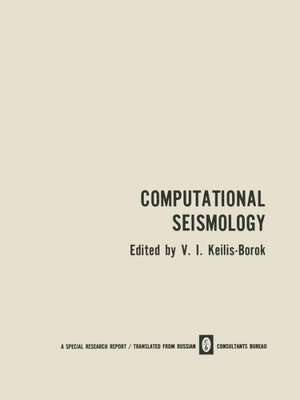Computational Seismology
Editat de V. I. Keilis-Boroken Limba Engleză Paperback – 29 apr 2012
Preț: 393.52 lei
Nou
Puncte Express: 590
Preț estimativ în valută:
75.30€ • 78.83$ • 62.31£
75.30€ • 78.83$ • 62.31£
Carte tipărită la comandă
Livrare economică 05-19 aprilie
Preluare comenzi: 021 569.72.76
Specificații
ISBN-13: 9781468488173
ISBN-10: 1468488171
Pagini: 236
Ilustrații: VIII, 228 p. 80 illus.
Dimensiuni: 210 x 279 x 12 mm
Greutate: 0.54 kg
Ediția:1972
Editura: Springer Us
Colecția Springer
Locul publicării:New York, NY, United States
ISBN-10: 1468488171
Pagini: 236
Ilustrații: VIII, 228 p. 80 illus.
Dimensiuni: 210 x 279 x 12 mm
Greutate: 0.54 kg
Ediția:1972
Editura: Springer Us
Colecția Springer
Locul publicării:New York, NY, United States
Public țintă
ResearchCuprins
Introduction: Seismology and Logic.- I: Automation of Seismological Surveys.- Computer Determination of Earthquake Epicenters.- Computer Determination of Earthquake Focal Depth.- Automatic Identification of Seismic Wave Arrivals.- Computer Determination of Earthquake Mechanism.- II: Seismic Waves.- Some Problems of the Use of P-Wave Dynamics to Find the Velocity Profile of the Upper Mantle.- The Effect of Focal Depth in the Crust on the Wave Field in the Initial Part of a Seismogram.- Approximation of Velocity Distributions for Calculation of P-Wave Times and Amplitudes.- Amplitudes of Fundamental Seismic Waves in the Mantle.- Interference Head Waves.- Method for Calculating Surface Rayleigh Waves in a Vertically Inhomogeneous Half-Space.- Higher Modes of Rayleigh Waves and Upper Mantle Structure.- Surface-Wave Amplitude Spectra.- III. Inverse Problems of Seismology.- Inverse Problems of Seismology (Structural Review).- Determining Seismic Profiles from a Set of Observations.- Expediting Body Wave Calculations.- Determining Seismic-Wave Velocity from Travel-Time Curves.- Properties of Surface-Source Travel-Time Curves.- Characteristic Properties of Deep-Focus Travel-Time Curves.- Finding a Velocity Profile from a Love Wave Dispersion Curve: Problems of Uniqueness.- IV: Statistical Applications.- Effect of Station and Source Factors on the Accuracy of Seismic Parameter Determination.- A Statistical Method for Determining Earthquake Focal Depth from the Record of One Seismic Station.- Local Statistics of Earthquake Catalogs.

















